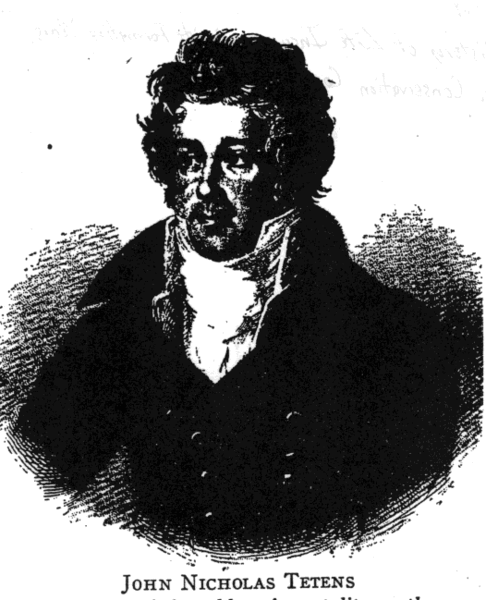<Back to Index>
- Philosopher Johannes Nikolaus Tetens, 1736
- Composer Jacques Mauduit, 1557
- 11th Ming Emperor of China Jiajing, 1507
PAGE SPONSOR

Johannes Nikolaus Tetens (16 September 1736 – 17 August 1807) was a German philosopher, statistician and scientist.
He has been called 'the German Hume', on the basis of a comparison of his major work Philosophische Versuche über die menschliche Natur und ihre Entwickelung (1777) with David Hume's A Treatise of Human Nature. He is considered to have been an influence on Immanuel Kant.
Born 1736 in Tetenbuell (Holstein). From 1760, he taught philosophy and physics ("natural philosophy" at that time) in the Buetzow Academy (Mecklenburg - Western Pomerania). During this decade, he wrote many treatises on various subjects, ranging from the color of the sky to the existence of God through the origins of languages. After this polygraphic formation period, Tetens went back to more fundamental enquiries: after having read David Hume's work, he popularized it throughout the German speaking world. Tetens is therefore supposed to have introduced Immanuel Kant to phenomenological thought and to the empiricism / transcendence dualism.
In 1776, Tetens became Professor of Philosophy at the University of Kiel, which might have appeared to be his final professional position. Nonetheless, in the years following 1789, Tetens begun another career as a high ranking Danish civil servant: member of the Finanzcollegium in Copenhagen, then (1791) counselor of state, and (1803) co-director of the state bank and director of the widow pension funds. By this time, he was interested in pure maths as well as in applications. His interest in polynomial algebra was influenced by his belonging to the German combinatorial school of Carl Friederich Hindenburg, Christian Kramp and others. His main applied work was concentrated on actuarial mathematics.
The book Einleitung zur Berechnung der Leibrenten und Anwartschaften, published in Leipzig in 1785 (erster teil) - 1786 (zweiter teil) was a landmark of actuarial science. It contains an extensive synthesis of previous work on the subject, from Halley's mortality table to Richard Price's Observations on reversionary payments. It is recognized by actuaries for featuring the first risk measure ever (the Risico der Casse); moreover it offers some insights in mathematical statistics: by using an approximation of the binomial distribution, Tetens tried to compute the confidence level of a given sampling procedure.